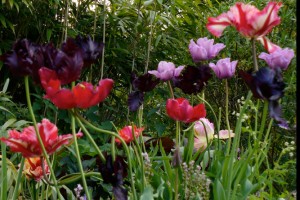





 A bog garden is similar to other water garden environments, but it does demand slightly different cultural practices. The plants should be allowed to grow freely in the soil, unrestrained by planting containers. This ensures a very natural appearance and lusty growth, but also creates its own management problems.
A bog garden is similar to other water garden environments, but it does demand slightly different cultural practices. The plants should be allowed to grow freely in the soil, unrestrained by planting containers. This ensures a very natural appearance and lusty growth, but also creates its own management problems.
Most bog garden plants will grow in the majority of soils if they are kept constantly moist. However, in their natural environment, the growing medium is rich in organic material. Therefore, incorporating organic matter into the soil is desirable, although this can be hazardous if it is in direct contact with the water of an adjacent pool. Nutrients can leach out into the water and create an algal bloom in the pool, which will be uncontrollable because of the huge nutrient reserve in the bog garden.
Mix only well rotted organic material with the soil, preferably not from animal manure. A friable decomposed leaf mould is ideal, since it will add humus to the soil without over-burdening it with nutrients. Not that the bog garden soil should be impoverished. On the contrary, it needs to be fertilized to sustain the substantial leafy growth that most bog garden plants produce. Initially, a good general garden soil, of medium-to-heavy structure, should be adequate, although within 18 months some feeding will be required. Use slow release capsules or pellets, distributed close to the plants, and apply an annual spring mulch of well rotted organic matter. The purpose of the latter is not to conserve moisture, but to top up the organic content of the soil, which will dissipate rapidly under the very wet conditions.
When planting a new bog garden, it is preferable for the soil not to be saturated; heavy sticky soil is extremely difficult to plant into properly. Planting will be easier under the drier conditions normally found elsewhere in the garden, then the bog garden can be subjected to inundation. However, if soil preparation is undertaken before a winter, it will be difficult to achieve this ideal.
Dig the area thoroughly in the autumn, turning up the soil in large lumps, which should be left exposed to the weather. The rain and frost will break them down into a fine tilth for the spring. This also helps rid the soil of many undesirable pests. When digging, mix the organic matter into the bottom of the trench and cover it over. If you can make preparations like this in the autumn, spring planting will be much easier and more successful.
The manner in which bog garden plants are arranged largely depends upon the feature’s scale. The commonest mistake is to plant only one example of each plant; even if you only have a modest patch, planting fewer varieties in small groups of three will produce a much better effect. Although the keen gardener will want to use the opportunity offered by these special conditions to try as wide a range of plants as possible, the overall appearance of the bog garden must be considered.
Treat a bog garden in much the same way as an herbaceous border arrangement, grouping the plants in relation to their heights and colours, in a manner that appeals. Be aware of their vigour, for a number can be quite rampant in good boggy conditions. In fact, on occasion, there may be a case for eliminating a plant from your scheme because it may rampage and upset the whole effect, creating maintenance problems. The fast creeping bog and marginal Houttuynia cordata is one of the worst culprits.
Within a large bog garden, it is possible to isolate some of the more vigorous plants by dividing the area into sections where they can be accommodated and left to grow freely. Use fine-mesh plastic garden netting, burying it in the soil. This will effectively restrain the plants while permitting moisture to pass through, ensuring a consistent moisture level throughout the bog garden.
Most bog garden plants are sold in containers. Plant them carefully in a hole that is larger than the pot ball and add a generous quantity of peat or well composted hark to the soil as the hole is backfilled. As with all plants, this friable organic matter in the immediate vicinity of the roots will encourage the rapid development of root hairs and speedy establishnient of the plants.
If the pot-ball is solid and the plant appears to be potbound, it is wise to disrupt the root-ball a little without causing a check in growth. Simply run a knife gently down the side of the pot-ball in two or three places, then insert your fingers and tease the roots out a little. This will allow them to penetrate the surrounding soil much sooner. A tight pot-ball can be quite constraining, the plant remaining isolated and producing stunted growth for a season or more, merely because it is growing in a different medium to that in which its roots have become tightly entangled
Many bog garden plants are available in bare-rooted form. Those purchased from a nursery should he healthy and vigorous young stock, which has been produced as a result of regular lifting and dividing. If planted during the dormant season, they will establish quickly.
If you intend using bog garden plants that have been growing elsewhere in the garden, or that may have been given to you by a friend, be sure that you only use the vigorous outer portions from large clumps. The hardy woody inner parts of plants like Siberian iris and astilbe rarely develop quickly into attractive and presentable plants. Unless there is no other stock available, these should be discarded.
Copyright © www.100flowers.win Botanic Garden All Rights Reserved